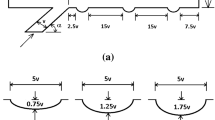Abstract
Cooling the blades of gas turbines is essential for extending the life of the blades. Conventional gas turbines use air-film cooling. With the increase in turbine inlet temperatures, novel cooling methods are required. Recently mist cooling started to gain prominence for high-capacity gas turbines. Mist cooling involves adding water droplets in the form of a fine mist to the air in conventional film cooled systems. This paper numerically investigates the performance of mist cooling at various mist concentrations for two different hole configurations. The cooling effectiveness for a coolant injection hole with diffusion angle of 10° and 15° was analyzed with mist concentration varied from 1 to 7%. The results show that with a low mist concentration of 1%, the cooling effectiveness improved drastically for both configurations. A maximum of 69% improvement was observed for 7% mist concentration and 10° diffused hole. Mist concentrations above 5% did not offer any significant improvements as with lower concentrations.








Similar content being viewed by others
Abbreviations
- BR:
-
Blowing ratio
- C :
-
Concentration
- C p :
-
Specific heat (J kg−1 K−1)
- D :
-
Diffusion coefficient (m2 s−1)
- d :
-
Diameter (mm, m)
- F :
-
Force (N)
- h :
-
Enthalpy (J kg−1)
- P :
-
Pressure (Pa)
- T :
-
Temperature (K)
- S :
-
Source term
- u :
-
Velocity (m s−1)
- c:
-
Coolant
- g:
-
Gas
- p:
-
Particle
- w:
-
Wall
- α :
-
Injection angle (°)
- β :
-
Diffusion angle (°)
- ρ :
-
Density (kg m−3)
- η :
-
Adiabatic cooling effectiveness
- κ :
-
Turbulent kinetic energy (m2 s−2)
- \(\epsilon\) :
-
Turbulent dissipation (m2 s−3)
- λ :
-
Thermal conductivity (W m−1 K−1)
- ν :
-
Kinematic viscosity (m2 s−1)
References
Bunker RS. A review of shaped hole turbine film-cooling technology. J Heat Transf. 2005;127(4):441–53. https://doi.org/10.1115/1.1860562.
Krewinkel R. A review of gas turbine effusion cooling studies. Int J Heat Mass Transf. 2013;1(66):706–22. https://doi.org/10.1016/j.ijheatmasstransfer.2013.07.071.
Lee KD, Kim KY. Shape optimization of a fan-shaped hole to enhance film-cooling effectiveness. Int J Heat Mass Transf. 2010;53(15–16):2996–3005. https://doi.org/10.1016/j.ijheatmasstransfer.2010.03.032.
Schmidt DL, Sen B, Bogard DG. Film cooling with compound angle holes: adiabatic effectiveness. J Turbomach. 1996;118(4):807–13. https://doi.org/10.1115/1.2840938.
Goldstein RJ, Jin P. Film cooling downstream of a row of discrete holes with compound angle. J Turbomach. 2001;123(2):222–30. https://doi.org/10.1115/1.1344905.
Cunha FJ. Integrated steam/air cooling system for gas turbines. United States Patent US 5,340,274. 1994.
Cunha FJ. Integrated steam and air cooling for combined cycle gas turbines. United States Patent US 5,253,976. 1993.
Wang W, Gao J, Shi X, Xu L. Cooling performance analysis of steam cooled gas turbine nozzle guide vane. Int J Heat Mass Transf. 2013;1(62):668–79. https://doi.org/10.1016/j.ijheatmasstransfer.2013.02.080.
Xu L, Wang W, Gao T, Gao J. An experimental research on the cooling performance of the turbine vane with an advanced duplex-medium combined cooling. Int J Heat Mass Transf. 2014;79:72–81. https://doi.org/10.1016/j.expthermflusci.2014.07.004.
Zhao L, Wang T. An experimental study of mist/air film cooling on a flat plate with application to gas turbine airfoils—part II: two-phase flow measurements and droplet dynamics. J Turbomach. 2014. https://doi.org/10.1115/1.4025738.
Li X, Wang T. Simulation of film cooling enhancement with mist injection. J Heat Transf. 2006;128(6):509–19. https://doi.org/10.1115/1.2171695.
Li X, Wang T. Effects of various modeling schemes on mist film cooling simulation. J Heat Transf. 2007;129(4):472–82. https://doi.org/10.1115/1.2709959.
Li X, Wang T. Two-phase flow simulation of mist film cooling on turbine blades with conjugate internal cooling. J Heat Transf. 2008;130(10):102901. https://doi.org/10.1115/1.2944247.
Wang T, Li X. Mist film cooling simulation at gas turbine operating conditions. Int J Heat Mass Transf. 2008;51(21–22):5305–17. https://doi.org/10.1016/j.ijheatmasstransfer.2008.04.040.
Wang T, Li X, Pinninti V. Simulation of mist transport for gas turbine inlet air cooling. Numer Heat Transf A Appl. 2008;53(10):1013–36. https://doi.org/10.1080/10407780701790003.
Dhanasekaran TS, Wang T. Simulation of mist film cooling on rotating gas turbine blades. J. Heat Transf. 2012;134(1):011501. https://doi.org/10.1115/1.4004480.
Versteeg HK, Malalasekera W. An introduction to computational fluid dynamics: the finite, vol. method. London: Pearson Education; 2007.
Ansys Fluent 12.0 documentation, Section 15.2.2, Turbulent dispersion of particles, Ansys Inc.
Rao PM, Biswal P, Prasad BV. A computational study of mist assisted film cooling. Int Commun Heat Mass Transf. 2018;1(95):33–41.
Author information
Authors and Affiliations
Corresponding author
Additional information
Publisher's Note
Springer Nature remains neutral with regard to jurisdictional claims in published maps and institutional affiliations.
Rights and permissions
About this article
Cite this article
Gandhi, N., Suresh, S. Effect of mist concentration on the cooling effectiveness of a diffused hole mist cooling system. J Therm Anal Calorim 141, 2231–2238 (2020). https://doi.org/10.1007/s10973-020-09680-1
Received:
Accepted:
Published:
Issue Date:
DOI: https://doi.org/10.1007/s10973-020-09680-1




